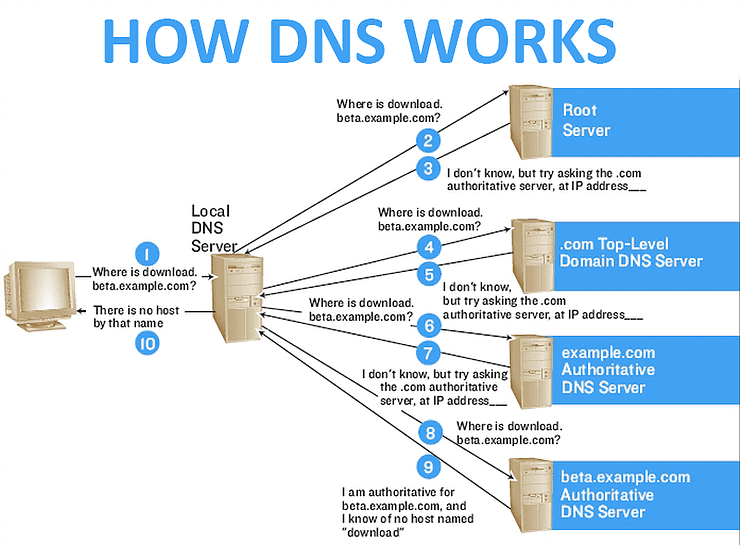How DNS Works?

The Domain Name System (DNS) is a critical component of the internet infrastructure that translates human-readable domain names into numerical IP addresses, enabling the efficient communication between devices over the internet. DNS plays a fundamental role in connecting users to websites and other online resources. Let's explore how DNS works in a step-by-step process: 1. Step 1: Requesting a Domain Name When you enter a URL (Uniform Resource Locator) or a web address into your web browser, such as "www.none.edu.vn," your device initiates a request to access the website associated with that domain name. 2. Step 2: Checking Local Cache The first place your device looks for the IP address corresponding to the domain name is its local cache. DNS information is temporarily stored on your device after previous visits to websites. If the IP address is found in the cache, the translation process ends, and the website is accessed directly. 3. Step 3: Contacting Recursive DNS Server If the IP address is not found in the local cache, your device contacts a Recursive DNS Server (also known as a Resolver). This server is provided by your Internet Service Provider (ISP) or another third-party DNS service. 4. Step 4: Recursive DNS Server Lookup The Recursive DNS Server checks its cache to see if it already has the IP address for the requested domain name. If it does, it returns the IP address to your device, and the process is complete. 5. Step 5: Querying the Root Nameservers If the Recursive DNS Server does not have the IP address, it needs to find the authoritative DNS server for the domain name. To do this, it queries the Root Nameservers. There are 13 sets of Root Nameservers distributed worldwide, and they contain information about the top-level domain (TLD) servers for each domain extension (e.g., .com, .org, .net). 6. Step 6: Querying TLD Nameservers The Root Nameservers respond to the Recursive DNS Server's query by providing the IP addresses of the TLD Nameservers responsible for the specific top-level domain. For example, if the domain is "none.edu.vn," the Recursive DNS Server is directed to the .vn TLD Nameservers. 7. Step 7: Querying Authoritative Nameservers The Recursive DNS Server then contacts the TLD Nameservers, which, in turn, provide the IP addresses of the Authoritative Nameservers responsible for the "none.edu.vn" domain. 8. Step 8: Getting the IP Address Finally, the Recursive DNS Server contacts the Authoritative Nameservers for "none.edu.vn," which hold the definitive IP address for the domain. The Authoritative Nameservers respond with the correct IP address, which is then passed back through each level of DNS servers until it reaches your device. 9. Step 9: Accessing the Website With the IP address obtained, your device can now access the web server hosting the website associated with the original domain name. The website's content is retrieved and displayed on your web browser, allowing you to interact with the website as intended. The Domain Name System (DNS) plays a crucial role in translating domain names into numerical IP addresses, facilitating the smooth and efficient communication between devices on the internet. By following the steps outlined above, DNS ensures that users can easily access websites and other online resources by simply typing human-readable domain names into their web browsers, making the internet accessible and user-friendly for billions of people worldwide.